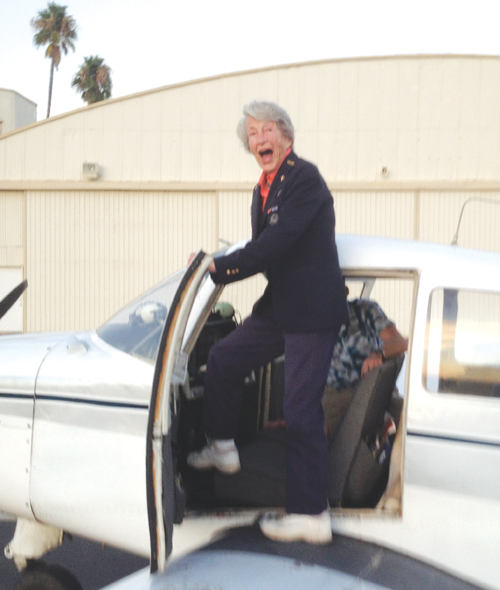
Garrett Woods, a flight instructor for the Hemet Flight Center at Hemet-Ryan Airport, is readying his last student of the day for a sunset flight. He goes through the standard safety check and prepares to take off.
The routine is the same as any other, except that on this day, Tuesday, Oct. 2, the student is a pioneer in aviation, a World War II veteran, the former member of a flying circus and a long-time flight instructor herself. She also has a special place in Idyllwild’s history.
Woods guides the B-19 Beechcraft Sport through a smooth takeoff and heads east.
Once at a comfortable altitude he looks at his student and says, “OK, Dot, you have the flight control.” Without hesitation, 97-year-old Dorothy “Dot” Swain Lewis grasps the yoke, asks where they’re going and guides the plane above the San Jacinto Mountains.

Dot would later describe the flight as a “nice little ride,” one of many under the veteran’s belt.
She was diagnosed with Alzheimer’s disease about three years ago and, although it’s been around 15 years since she’d piloted a plane and more than 35 since she’d trained pilots, she speaks as if it were all just yesterday.
Dot’s son, Albert “Chig” Zelius Lewis, rides behind his mother, happy to be joining her on a flight they’d done before, one of many over the years. “It was a lot of fun for her to be back in the cockpit,” Albert said. “It was a kick in the pants — a blast from the past.”
Dot decided to take up flight lessons in 1940.
After the bombing of Pearl Harbor there was a growing demand for qualified instructors, but at the time only men were hired.
Phoebe Omlie, the first woman pilot in the U.S. to obtain a commercial license, worked with Congress to establish the first-of-its-kind Women’s Research Flight Instructor School in Nashville, Tenn., and in 1942 Dot was one of 10 qualified pilots to join the program.
Soon she was off to New Mexico to teach Navy men to fly. She says the first and most important thing she taught her students is how to make a successful forced landing if anything goes wrong.
Dot flies past Dutch Flat, where she later says she would have made a successful forced landing if need be (eyes always searching for a clearing, just as she taught her students to do even before take-off and not one ever had a “crack-up”).
When the Navy pilot training program began to slow down in 1943, Dot joined many of her colleagues in the newly formed Women’s Air Force Service Pilots program. She started as an instructor and because she so enjoyed flying, eventually entered the WASP program as a trainee. Of the 25,000 women who applied, only 1,074 successfully graduated.
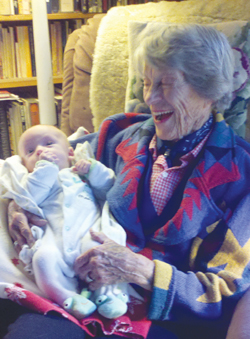
These highly qualified pilots ferried and tested planes; they flew B-17s, B-24s, B-25s, cargo aircraft, pursuit fliers and liaison aircraft, advanced trainers and basic trainers and the B-29. WASP Ann Baumgartner Carl was assigned to test the U.S.’s first jet, the Bell YP-59A.
Dot flies past the Idyllwild Arts Campus, formerly Idyllwild School of Music and the Arts — the place she first visited in 1954 — and spent her summers between teaching at the Orme School in Mayer, Ariz. — first as a painting and ceramics student and eventually as an instructor.
The WASP program was disbanded in 1944. Dot went on to perform in a flying circus, executing daring stunts such as a slow roll at only 40 feet above ground. But by then Albert was born and Dot performed 13 more stunts before realizing she didn’t want to make him an orphan.
Dot makes her way over the trees, houses and businesses that make up the quaint town of Idyllwild, a town Dot grew to love and eventually made her permanent home in 1977.

It was in 1977, some 30 years after the war that WASP women were finally given veterans’ status. In 1984 they were awarded the Victory Medal and American Theater Medals.
After the war, Dot focused her talents on art. She drew cartoons, painted and took up sculpture and continued to teach flight instruction at the Orme School.
Dot guides the plane toward Tahquitz Rock and they look down, trying to spot the home Dot had built on 1.5 acres in Fern Valley in 1958. Once past Tahquitz, Dot guides the plane through a 180-degree turn and heads back toward the airport.
Neighbor and close friend Julie Morgan McCoart arranged for the flight. The year before Dot’s longtime friend and horseback riding partner Cindy Allert managed to get Dot back in the saddle.
“How do you top horseback riding at 96?” Julie thought, “Flying a plane at 97!”
Albert says that, like getting back on the horse, his mother was nervous and shied away from the idea. When Julie asked her, “Dot, would you like to take a flight in a small plane?” Dot, quick as a whip replies, “Not necessarily. Only if I can fly it!”
Julie knew she could arrange it, since her husband’s son is Garrett Woods.
So, at her 97th birthday party on Sept. 30, it was announced that Julie took on Dot’s challenge.
And just as Dot was a steady and solid horseback rider at the age of 96, she could pilot a plane at 97. “She absolutely knew what she was doing,” Woods said.
Although the plane was more modern than Cubs she’d last been up in, once in the pilot’s seat she had no apprehension. “Why should I be afraid to hop into a plane that was a little different? And I wasn’t,” she says.
“That little memory was an important one, one that will stay with her,” Albert says of the flight. He explains how so many memories get lost or confused with others for his mother, but that the flight, like the horseback ride, will remain.
There’s a small army of friends and neighbors, some new, others who go way back, who make it possible for Dot to stay in her home.
One neighbor found her a roommate, so Dot would always have someone there. Melissa Severa and her two daughters Amma, 10, and Octavia, 7, live in the addition Dot built for her long-time friend and fellow WASP Winifred “Win” Wood. Win died in 2009.
For this past year, since Albert and neighbors noticed the disease made everyday life more and more challenging, Dot is never alone.
Dancing, singing, storytelling and a great deal of laughter fill her home.
Dot has company watching her favorite old shows, like “Gunsmoke” and “Bonanza.”
She has company eating her meals.
She has company walking her property.
She lights up like a child on Christmas morning when a baby enters the room or a favorite old song comes on and her joy is contagious.
Albert lives in Arlington, Virginia, and is ready to have his mother come stay with him for any length of time. However, he thinks she’s better off in her home.
“She’s fighting it (the dementia) really well,” he says. “It’s because of the people around her who have helped her keep her identity.” Albert says it’s a gift that her friends and neighbors will go to such lengths, not only to keep her in her home, but to keep her lifestyle going.
But as the people around her tell it, the gifts come from Dot.
Dot says she doesn’t have any motto in life. “No. No motto. Just fly,” she says and flashes her brilliant smile.
Ann L. Cooper and Dot wrote her biography, titled “How High She Flies.” It is available to check out at the Idyllwild library.
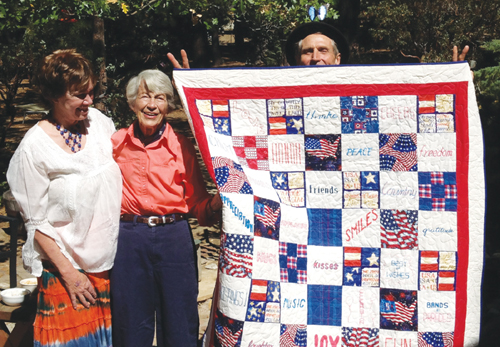









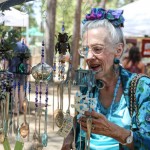


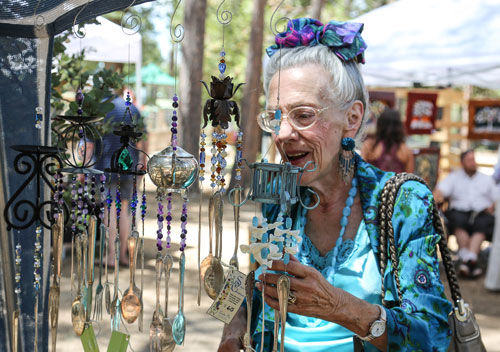

Long live Dot Lewis. You are a treasure, Dot!
Great article about Dot–loved reading it. Great writing, too, Halie!